child seat HONDA CIVIC COUPE 2016 10.G Owners Manual
[x] Cancel search | Manufacturer: HONDA, Model Year: 2016, Model line: CIVIC COUPE, Model: HONDA CIVIC COUPE 2016 10.GPages: 585, PDF Size: 17.41 MB
Page 8 of 585
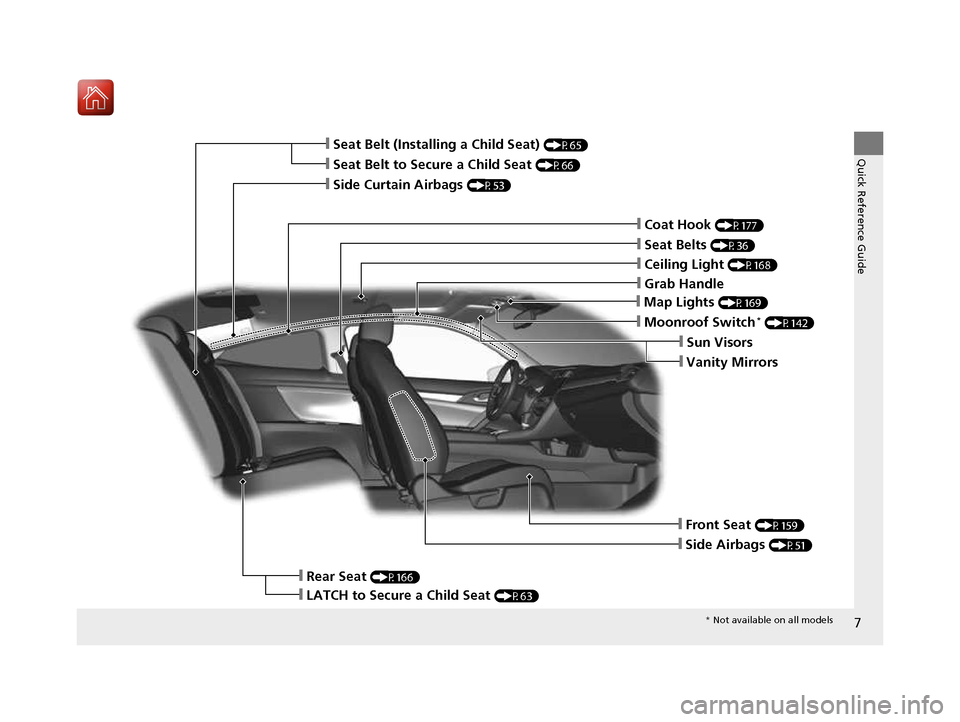
7
Quick Reference Guide❙Seat Belt to Secure a Child Seat (P66)
❙Seat Belt (Installing a Child Seat) (P65)
❙Moonroof Switch*
(P142)
❙Front Seat (P159)
❙Seat Belts (P36)
❙Side Airbags (P51)
❙Rear Seat (P166)
❙LATCH to Secure a Child Seat (P63)
❙Side Curtain Airbags (P53)
❙Coat Hook (P177)
❙Sun Visors
❙Vanity Mirrors
❙Map Lights (P169)
❙Grab Handle
❙Ceiling Light (P168)
* Not available on all models
16 CIVIC 2D HC2 (0A 01 0C)-31TBG6000.book 7 ページ >0>.>/6年>0月>/>0日 金曜日 午後4時>/6分
Page 11 of 585
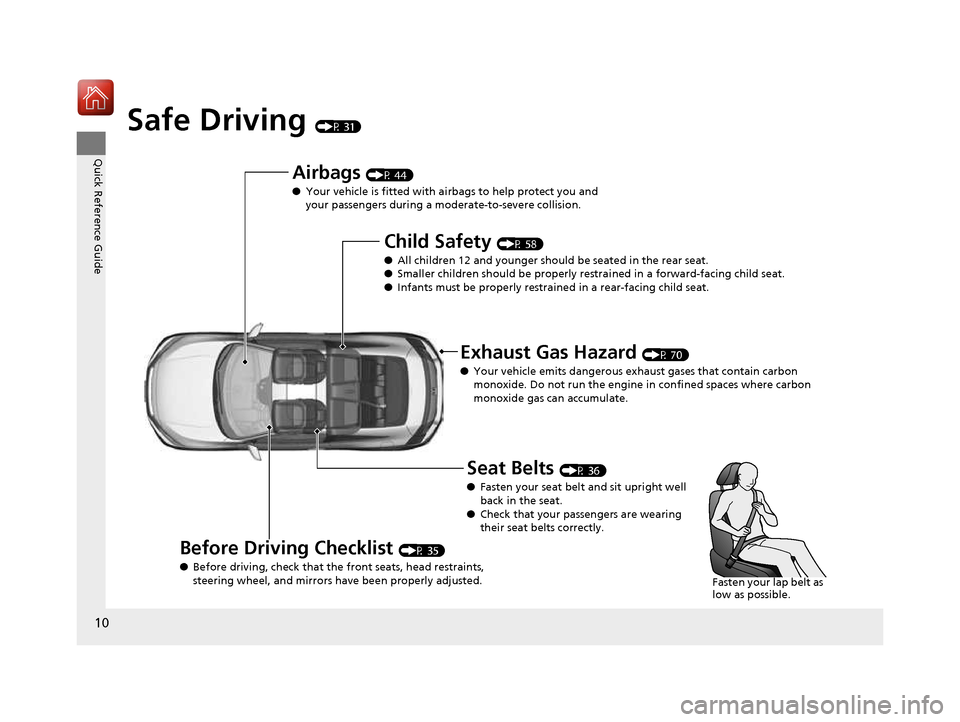
10
Quick Reference Guide
Safe Driving (P 31)
Airbags (P 44)
● Your vehicle is fitted with ai rbags to help protect you and
your passengers during a moderate-to-severe collision.
Child Safety (P 58)
● All children 12 and younger should be seated in the rear seat.
● Smaller children should be properly restra ined in a forward-facing child seat.
● Infants must be properly restraine d in a rear-facing child seat.
Exhaust Gas Hazard (P 70)
● Your vehicle emits dangerous exhaust gases that contain carbon
monoxide. Do not run the engine in confined spaces where carbon
monoxide gas can accumulate.
Before Driving Checklist (P 35)
● Before driving, check that the front seats, head restraints,
steering wheel, and mirrors have been properly adjusted. Seat Belts
(P 36)
● Fasten your seat belt and sit upright well
back in the seat.
● Check that your passengers are wearing
their seat belts correctly.
Fasten your lap belt as
low as possible.
16 CIVIC 2D HC2 (0A 01 0C)-31TBG6000.book 10 ページ >0>.>/6年>0月>/>0日 金 曜日 午後4時>/6分
Page 32 of 585
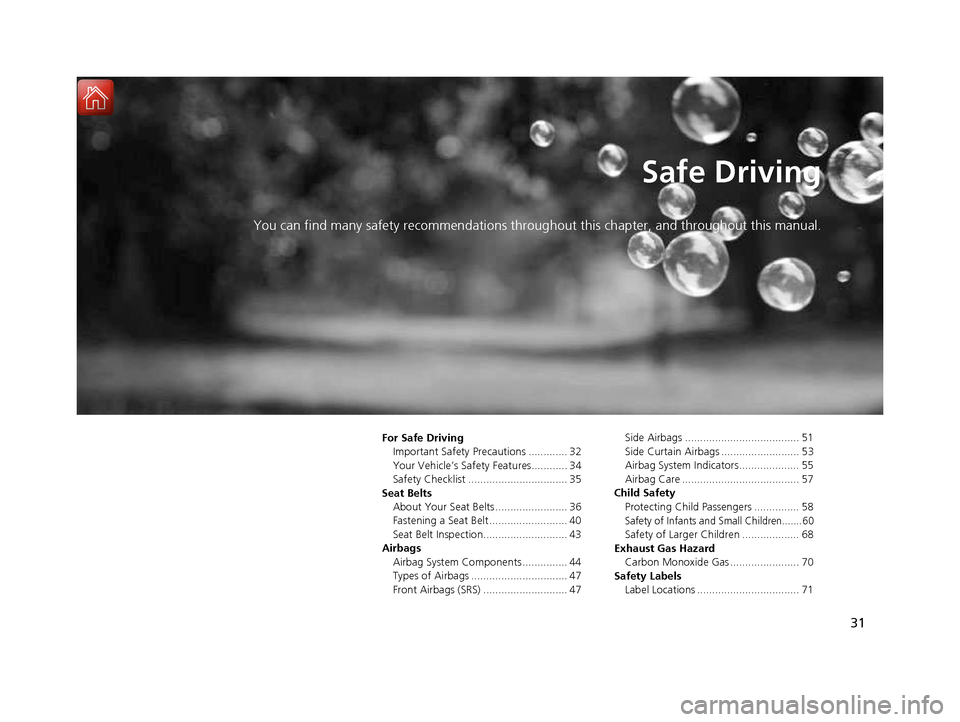
31
Safe Driving
You can find many safety recommendations throughout this chapter, and throughout this manual.
For Safe Driving Important Safety Precautions ............. 32
Your Vehicle’s Safety Features............ 34
Safety Checklist ................................. 35
Seat Belts About Your Seat Belts ........................ 36
Fastening a Seat Belt .......................... 40
Seat Belt Inspection............................ 43
Airbags Airbag System Components ............... 44
Types of Airbags ................................ 47
Front Airbags (SRS) ............................ 47 Side Airbags ...................................... 51
Side Curtain Airbags .......................... 53
Airbag System Indicators.................... 55
Airbag Care ....................................... 57
Child Safety Protecting Child Passengers ............... 58
Safety of Infants and Small Children.......60
Safety of Larger Children ................... 68
Exhaust Gas Hazard Carbon Monoxide Gas ....................... 70
Safety Labels
Label Locations .................................. 71
16 CIVIC 2D HC2 (0A 01 0C)-31TBG6000.book 31 ページ >0>.>/6年>0月>/>0日 金 曜日 午後4時>/6分
Page 33 of 585
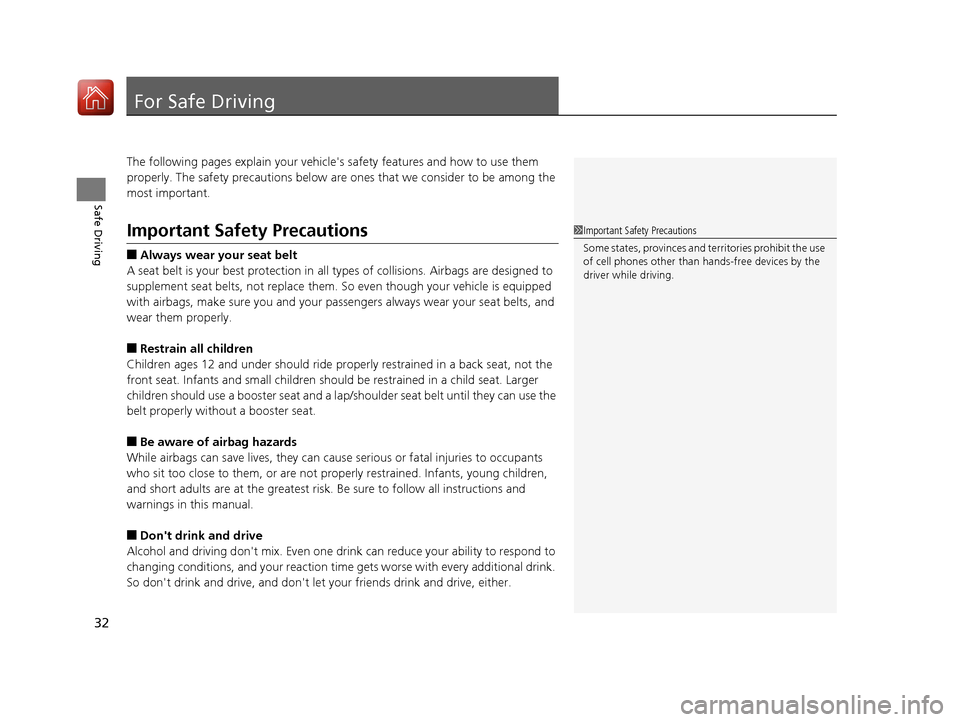
32
Safe Driving
For Safe Driving
The following pages explain your vehicle's safety features and how to use them
properly. The safety precauti ons below are ones that we consider to be among the
most important.
Important Safety Precautions ■ Always wear your seat belt
A seat belt is your best protection in all types of collisions. Airbags are designed to
supplement seat belts, not replace them. So even though your vehicle is equipped
with airbags, make sure you and your passe ngers always wear your seat belts, and
wear them properly. ■ Restrain all children
Children ages 12 and under should ride properly restrained in a back seat, not the
front seat. Infants and small children shoul d be restrained in a child seat. Larger
children should use a booster seat and a lap/shoulder seat belt until they can use the
belt properly without a booster seat. ■ Be aware of airbag hazards
While airbags can save lives, they can cause serious or fatal injuries to occupants
who sit too close to them, or are not prop erly restrained. Infants, young children,
and short adults are at the greatest risk. Be sure to follow all instructions and
warnings in this manual.
■ Don't drink and drive
Alcohol and driving don't mix. Even one dr ink can reduce your ability to respond to
changing conditions, and your reaction time gets worse with every additional drink.
So don't drink and drive, and don't let your friends drink and drive, either.1Important Safety Precautions
Some states, provinces and territories prohibit the use
of cell phones other than hands-free devices by the
driver while driving.
16 CIVIC 2D HC2 (0A 01 0C)-31TBG6000.book 32 ページ >0>.>/6年>0月>/>0日 金 曜日 午後4時>/6分
Page 36 of 585
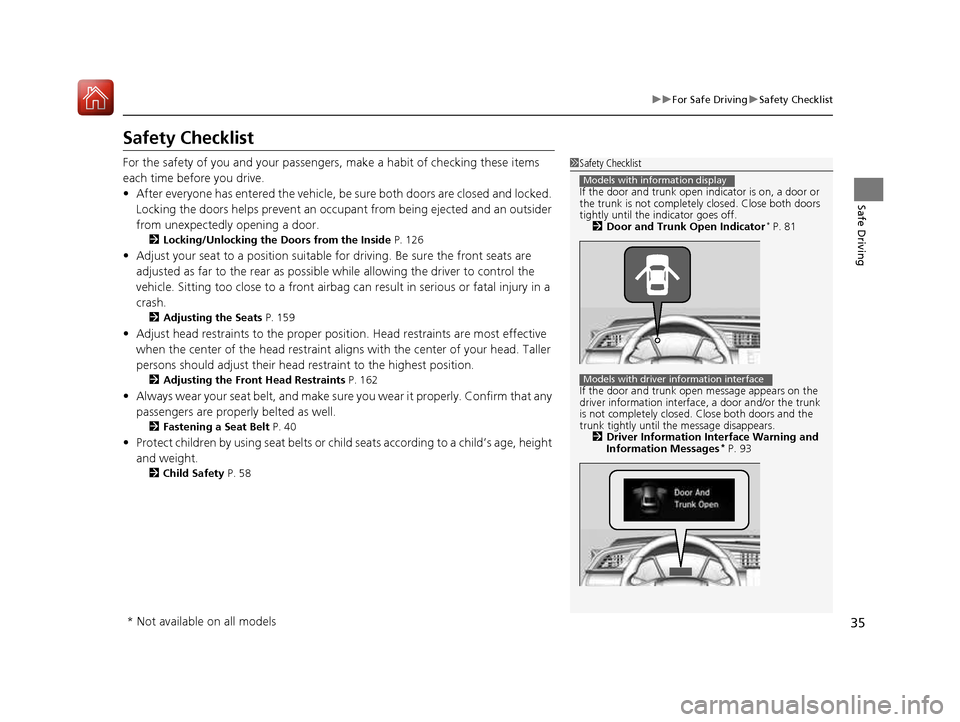
35
uuFor Safe DrivinguSafety Checklist
Safe Driving
Safety Checklist
For the safety of you and your passengers, make a habit of checking these items
each time before you drive. •After everyone has entered the vehicle, be sure both doors are closed and locked.
Locking the doors helps prevent an occupant from being ejected and an outsider
from unexpectedly opening a door. 2 Locking/Unlocking the Doors from the Inside P. 126
• Adjust your seat to a position suitable for driving. Be sure the front seats are
adjusted as far to the rear as possible while allowing the driver to control the
vehicle. Sitting too close to a front airbag can result in serious or fatal injury in a
crash. 2 Adjusting the Seats P. 159
• Adjust head restraints to the proper position. Head restraints are most effective
when the center of the head restraint alig ns with the center of your head. Taller
persons should adjust their head restraint to the highest position.
2 Adjusting the Front Head Restraints P. 162
• Always wear your seat belt, and make sure you wear it properly. Confirm that any
passengers are properly belted as well. 2 Fastening a Seat Belt P. 40
• Protect children by using seat belts or chil d seats according to a child’s age, height
and weight. 2 Child Safety P. 58
1Safety Checklist
If the door and trunk open indicator is on, a door or the trunk is not completely closed. Close both doors
tightly until the indicator goes off. 2 Door and Trunk Open Indicator *
P. 81
If the door and trunk ope n message appears on the
driver information interface , a door and/or the trunk
is not completely closed. Close both doors and the
trunk tightly until th e message disappears.
2 Driver Information Interface Warning and
Information Messages *
P. 93
Models with information display
Models with driver information interface
* Not available on all models
16 CIVIC 2D HC2 (0A 01 0C)-31TBG6000.book 35 ページ >0>.>/6年>0月>/>0日 金 曜日 午後4時>/6分
Page 37 of 585
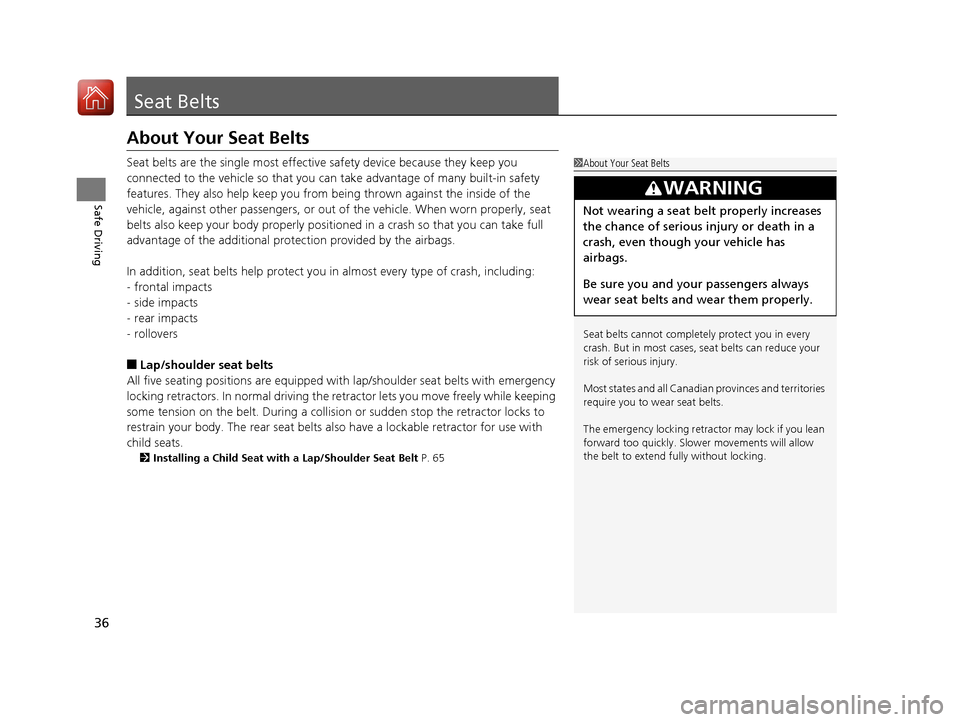
36
Safe Driving
Seat Belts
About Your Seat Belts
Seat belts are the single most effective safety device because they keep you
connected to the vehicle so that you can take advantage of many built-in safety
features. They also help keep you from be ing thrown against the inside of the
vehicle, against other passengers, or out of the vehicle. When worn properly, seat
belts also keep your body pr operly positioned in a crash so that you can take full
advantage of the additional protec tion provided by the airbags.
In addition, seat belts help protect you in almost every type of crash, including: - frontal impacts
- side impacts
- rear impacts
- rollovers
■ Lap/shoulder seat belts
All five seating positions are equipped with lap/shoulder seat belts with emergency
locking retractors. In normal driving the re tractor lets you move freely while keeping
some tension on the belt. During a collision or sudden stop the retractor locks to
restrain your body. The rear seat belts al so have a lockable retractor for use with
child seats. 2 Installing a Child Seat with a Lap/Shoulder Seat Belt P. 65
1About Your Seat Belts
Seat belts cannot completely protect you in every
crash. But in most cases, seat belts can reduce your
risk of serious injury.
Most states and all Canadian provinces and territories
require you to w ear seat belts.
The emergency locking retrac tor may lock if you lean
forward too quickly. Slower movements will allow
the belt to extend fu lly without locking.
3WARNING
Not wearing a seat belt properly increases
the chance of serious injury or death in a
crash, even though your vehicle has
airbags.
Be sure you and your passengers always
wear seat belts and wear them properly.
16 CIVIC 2D HC2 (0A 01 0C)-31TBG6000.book 36 ページ >0>.>/6年>0月>/>0日 金 曜日 午後4時>/6分
Page 39 of 585
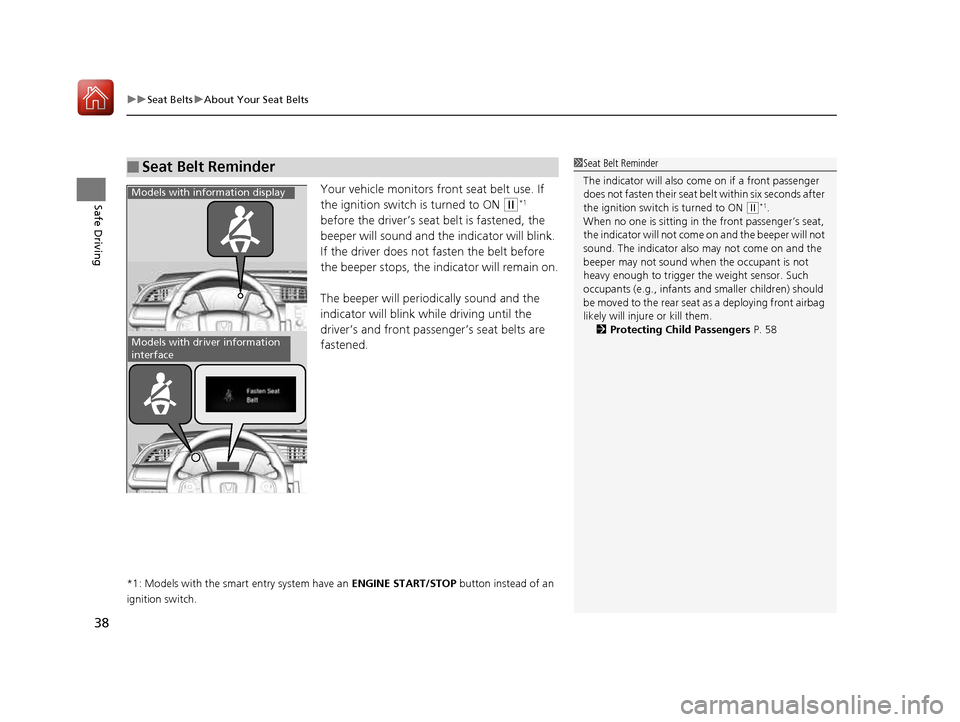
uuSeat BeltsuAbout Your Seat Belts
38
Safe DrivingYour vehicle monitors front seat belt use. If
the ignition switch is turned to ON
(w *1
before the driver’s seat belt is fastened, the
beeper will sound and the indicator will blink.
If the driver does not fasten the belt before
the beeper stops, the indicator will remain on.
The beeper will periodically sound and the
indicator will blink while driving until the
driver’s and front passenger’s seat belts are fastened.
*1: Models with the smart entry system have an ENGINE START/STOP button instead of an
ignition switch.
■Seat Belt Reminder1Seat Belt Reminder
The indicator will also co me on if a front passenger
does not fasten their seat belt within six seconds after
the ignition switch is turned to ON
(w *1
.
When no one is sitting in th e front passenger’s seat,
the indicator will not come on and the beeper will not
sound. The indicator also may not come on and the
beeper may not sound when the occupant is not
heavy enough to trigger th e weight sensor. Such
occupants (e.g., infants and smaller children) should
be moved to the rear seat as a deploying front airbag
likely will injure or kill them.
2 Protecting Child Passengers P. 58
Models with information display
Models with driver information
interface
16 CIVIC 2D HC2 (0A 01 0C)-31TBG6000.book 38 ページ >0>.>/6年>0月>/>0日 金 曜日 午後4時>/6分
Page 43 of 585
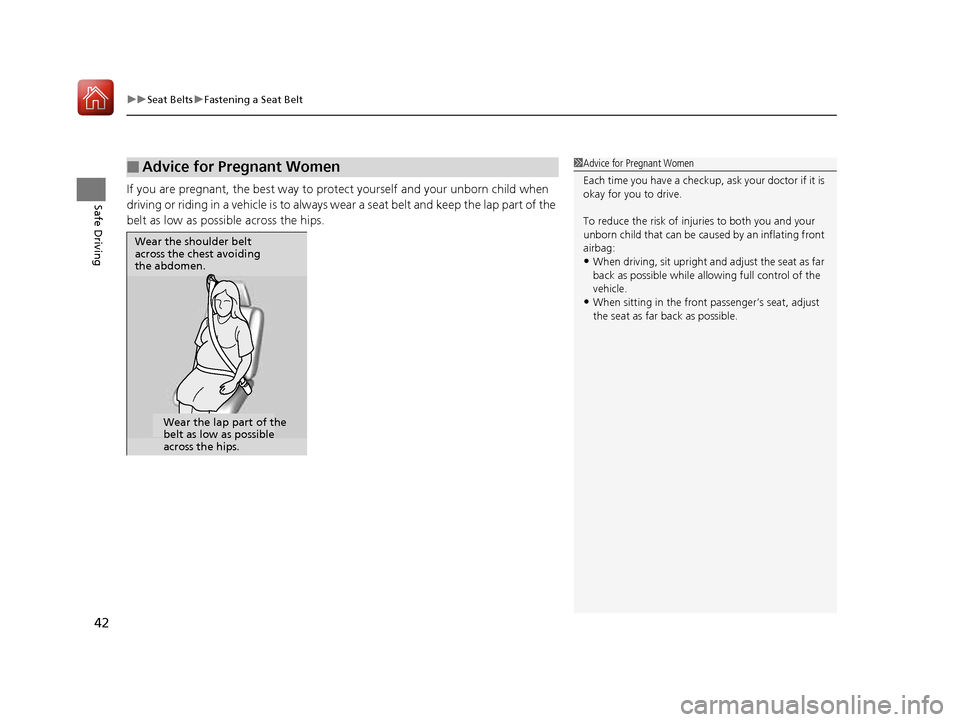
uuSeat BeltsuFastening a Seat Belt
42
Safe DrivingIf you are pregnant, the best way to protect yourself and your unborn child when
driving or riding in a vehicle is to always wear a seat belt and keep the lap part of the
belt as low as possi ble across the hips.
■Advice for Pregnant Women1Advice for Pregnant Women
Each time you have a checkup, ask your doctor if it is
okay for you to drive.
To reduce the risk of injuries to both you and your
unborn child that can be caus ed by an inflating front
airbag: • When driving, sit upright a nd adjust the seat as far
back as possible while allowing full control of the
vehicle.
• When sitting in the front passenger’s seat, adjust
the seat as far back as possible.
Wear the shoulder belt
across the chest avoiding
the abdomen.
Wear the lap part of the
belt as low as possible
across the hips.
16 CIVIC 2D HC2 (0A 01 0C)-31TBG6000.book 42 ページ >0>.>/6年>0月>/>0日 金 曜日 午後4時>/6分
Page 46 of 585
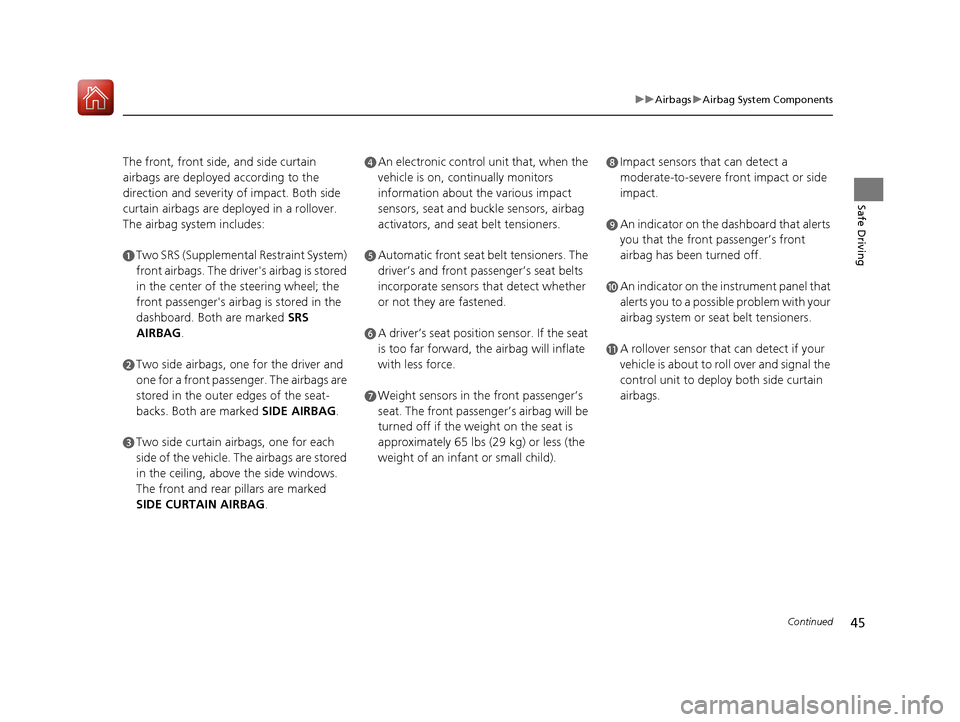
45
uuAirbagsuAirbag System Components
Continued
Safe Driving
The front, front side, and side curtain
airbags are deployed according to the
direction and severity of impact. Both side
curtain airbags are deployed in a rollover.
The airbag system includes:
aTwo SRS (Supplemental Restraint System)
front airbags. The driver's airbag is stored
in the center of the steering wheel; the
front passenger's airbag is stored in the
dashboard. Both are marked SRS
AIRBAG .
bTwo side airbags, one for the driver and
one for a front passenger. The airbags are
stored in the outer edges of the seat-
backs. Both are marked SIDE AIRBAG.
cTwo side curtain ai rbags, one for each
side of the vehicle. The airbags are stored
in the ceiling, above the side windows.
The front and rear pillars are marked
SIDE CURTAIN AIRBAG .
dAn electronic control unit that, when the
vehicle is on, continually monitors
information about the various impact
sensors, seat and buckle sensors, airbag
activators, and seat belt tensioners.
eAutomatic front seat belt tensioners. The
driver’s and front passenger’s seat belts
incorporate sensors that detect whether
or not they are fastened.
fA driver’s seat position sensor. If the seat
is too far forward, the airbag will inflate
with less force.
gWeight sensors in the front passenger’s seat. The front passenger’s airbag will be
turned off if the weight on the seat is
approximately 65 lbs (29 kg) or less (the
weight of an infant or small child).
hImpact sensors that can detect a
moderate-to-severe front impact or side impact.
iAn indicator on the dashboard that alerts
you that the front passenger’s front
airbag has been turned off.
jAn indicator on the instrument panel that
alerts you to a possible problem with your
airbag system or seat belt tensioners.
kA rollover sensor that can detect if your
vehicle is about to ro ll over and signal the
control unit to deploy both side curtain airbags.
16 CIVIC 2D HC2 (0A 01 0C)-31TBG6000.book 45 ページ >0>.>/6年>0月>/>0日 金 曜日 午後4時>/6分
Page 51 of 585
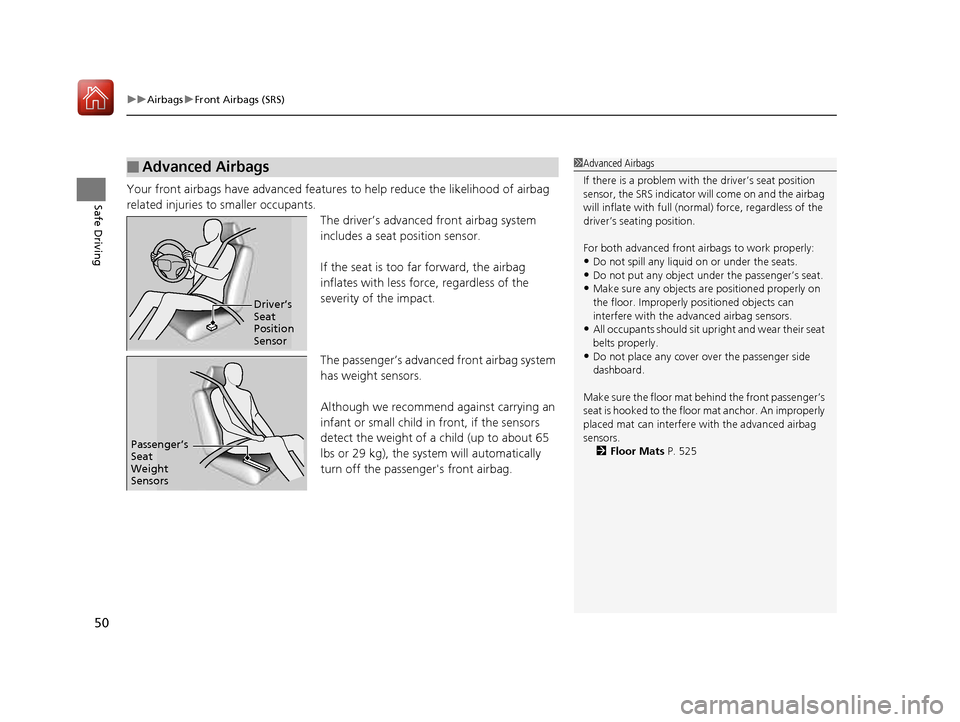
uuAirbagsuFront Airbags (SRS)
50
Safe DrivingYour front airbags have advanced features to help reduce the likelihood of airbag
related injuries to smaller occupants. The driver’s advanced front airbag system
includes a seat position sensor.
If the seat is too far forward, the airbag
inflates with less forc e, regardless of the
severity of the impact.
The passenger’s advanced front airbag system
has weight sensors.
Although we recommend against carrying an
infant or small child in front, if the sensors
detect the weight of a child (up to about 65
lbs or 29 kg), the syst em will automatically
turn off the passenger's front airbag.
■Advanced Airbags1Advanced Airbags
If there is a problem with the driver’s seat position
sensor, the SRS indicator wi ll come on and the airbag
will inflate with full (normal) force, regardless of the
driver’s seating position.
For both advanced front airbags to work properly: • Do not spill any liquid on or under the seats.
• Do not put any object under the passenger’s seat.
• Make sure any objects are positioned properly on the floor. Improperly pos itioned objects can
interfere with the advanced airbag sensors.
• All occupants should sit upri ght and wear their seat
belts properly.
• Do not place any cover over the passenger side dashboard.
Make sure the floor mat behind the front passenger’s
seat is hooked to the floor mat anchor. An improperly
placed mat can interfere with the advanced airbag sensors. 2 Floor Mats P. 525
Driver’s Seat Position
Sensor
Passenger’s Seat
Weight
Sensors
16 CIVIC 2D HC2 (0A 01 0C)-31TBG6000.book 50 ページ >0>.>/6年>0月>/>0日 金 曜日 午後4時>/6分